Abstract
The frequency of plasmids in chemically stressed bacterial populations was investigated by individually adding various concentration of kanamycin, ampicillin, and mercuric chloride to soil samples. Viable bacterial populations were enumerated, soil respiration was monitored for up to 6 weeks as an indicator of physiological stress, and bacterial isolates from stressed and control soils were screened for the presence of plasmids. Low levels of the chemical stress factors did not for the most part significantly alter population viability, soil respiration, or plasmid frequency. Exposure to high stress levels of mercury and ampicillin, however, resulted in altered numbers of viable organisms, soil respiration, and plasmid frequency. Plasmid frequency increased in response to ampicillin exposure but was not significantly changed after exposure to kanamycin. In mercuric chloride-stressed soils, there was a decrease in plasmid frequency despite an increase in overall mercury resistance of the isolates, suggesting that mercury resistance in these populations is largely, if not completely, chromosome encoded. Chemical stress did not cause an increase in plasmid-mediated multiple resistance. A genetic response (change in plasmid frequency) was not found unless a physiological (phenotypic) response (change in viable cells and respiratory activity) was also observed. The results indicate that a change in plasmid frequency is dependent on both the amount and type of chemical stress.
Full text
PDF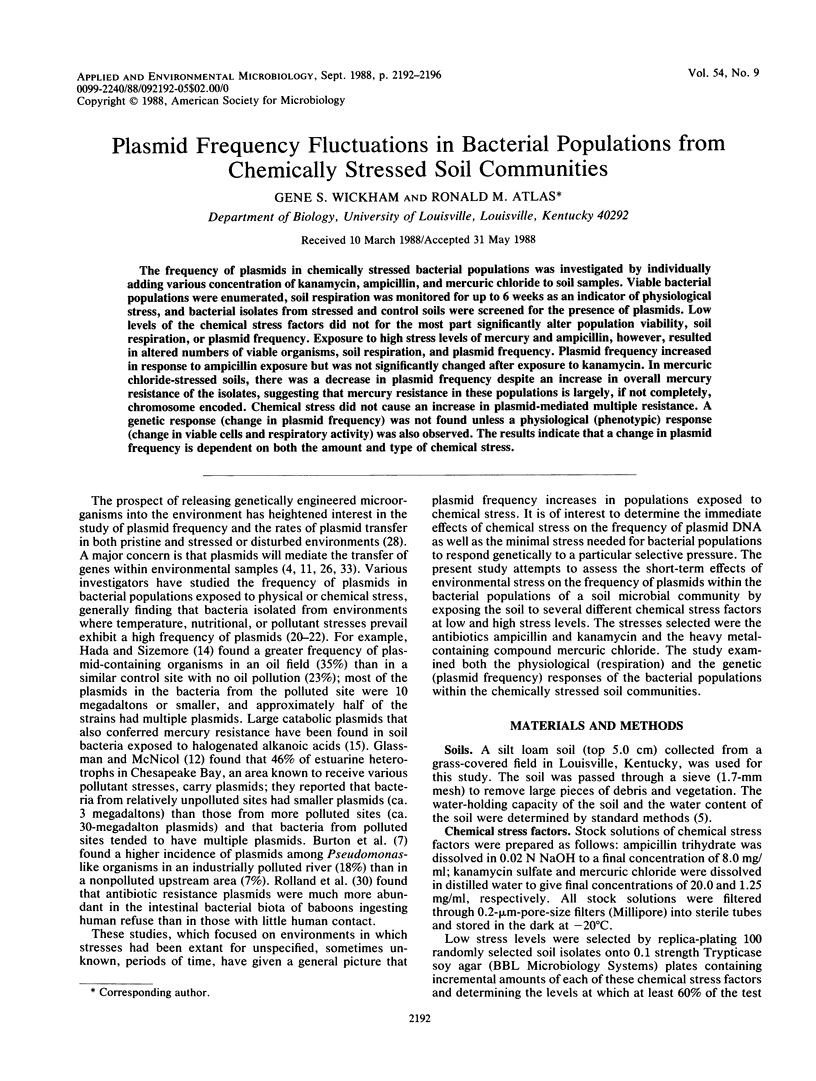
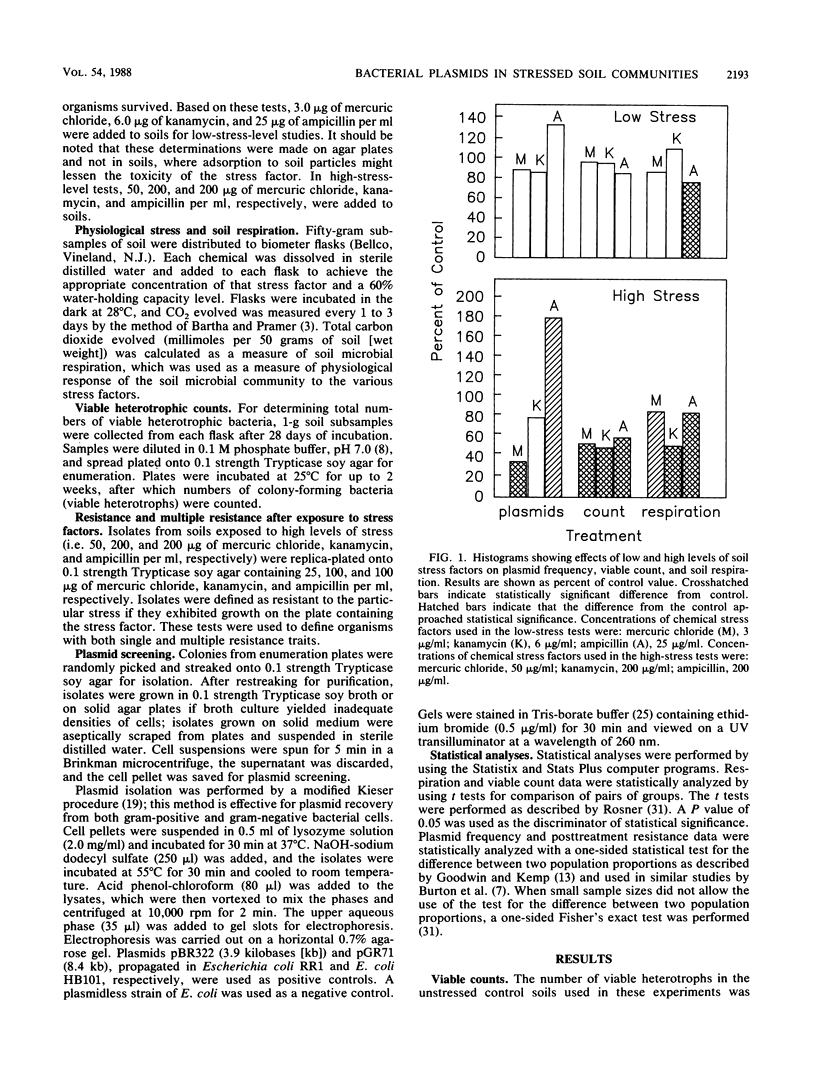
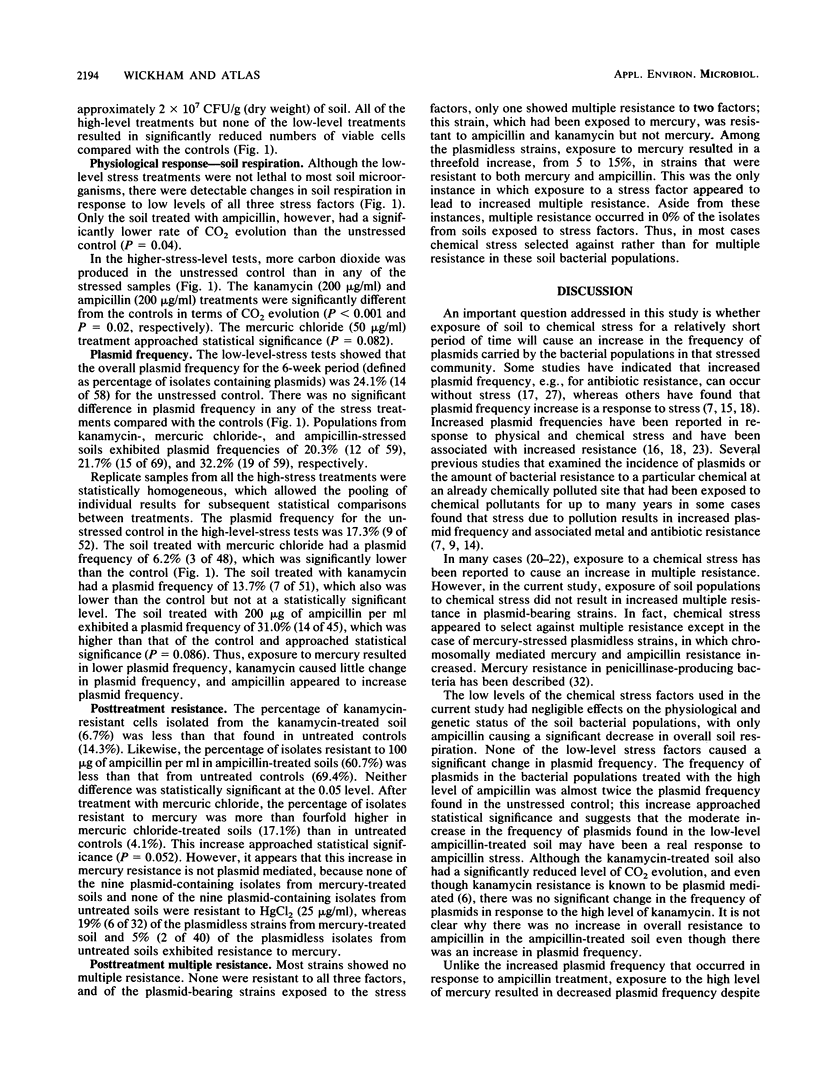
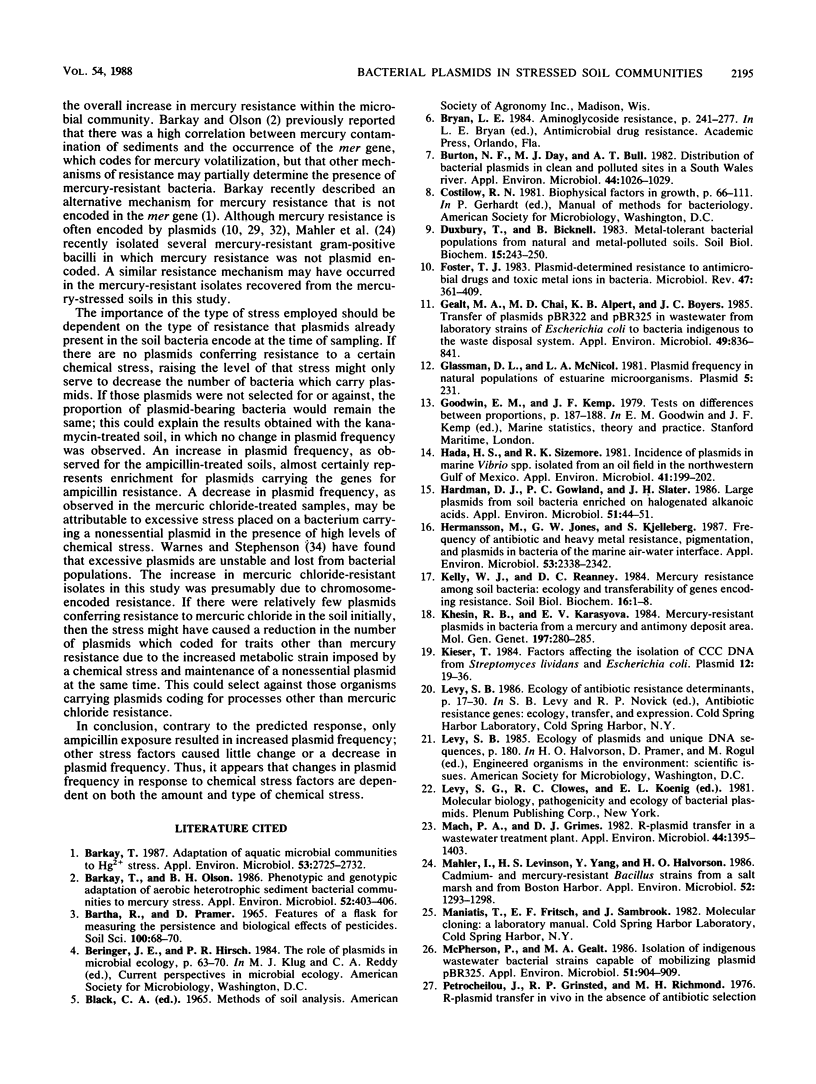
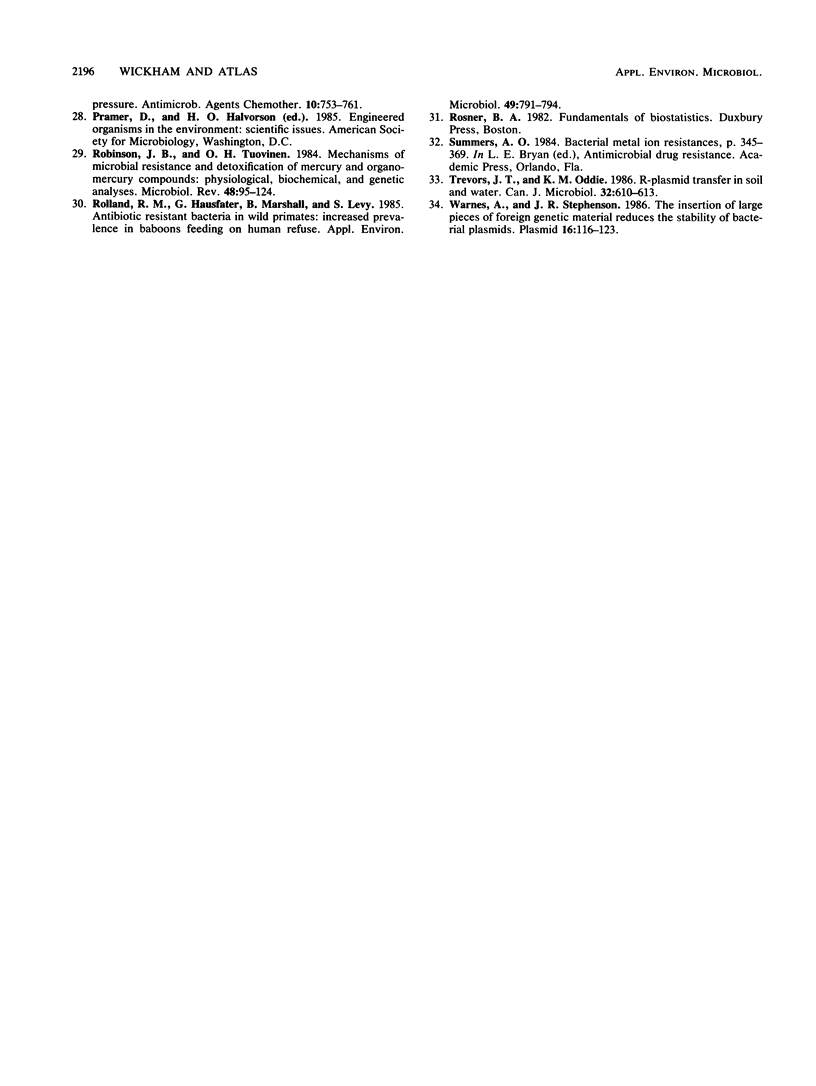
Selected References
These references are in PubMed. This may not be the complete list of references from this article.
- Barkay T. Adaptation of aquatic microbial communities to hg stress. Appl Environ Microbiol. 1987 Dec;53(12):2725–2732. doi: 10.1128/aem.53.12.2725-2732.1987. [DOI] [PMC free article] [PubMed] [Google Scholar]
- Barkay T., Olson B. H. Phenotypic and genotypic adaptation of aerobic heterotrophic sediment bacterial communities to mercury stress. Appl Environ Microbiol. 1986 Aug;52(2):403–406. doi: 10.1128/aem.52.2.403-406.1986. [DOI] [PMC free article] [PubMed] [Google Scholar]
- Burton N. F., Day M. J., Bull A. T. Distribution of bacterial plasmids in clean and polluted sites in a South Wales river. Appl Environ Microbiol. 1982 Nov;44(5):1026–1029. doi: 10.1128/aem.44.5.1026-1029.1982. [DOI] [PMC free article] [PubMed] [Google Scholar]
- Foster T. J. Plasmid-determined resistance to antimicrobial drugs and toxic metal ions in bacteria. Microbiol Rev. 1983 Sep;47(3):361–409. doi: 10.1128/mr.47.3.361-409.1983. [DOI] [PMC free article] [PubMed] [Google Scholar]
- Gealt M. A., Chai M. D., Alpert K. B., Boyer J. C. Transfer of plasmids pBR322 and pBR325 in wastewater from laboratory strains of Escherichia coli to bacteria indigenous to the waste disposal system. Appl Environ Microbiol. 1985 Apr;49(4):836–841. doi: 10.1128/aem.49.4.836-841.1985. [DOI] [PMC free article] [PubMed] [Google Scholar]
- Hada H. S., Sizemore R. K. Incidence of Plasmids in Marine Vibrio spp. Isolated from an Oil Field in the Northwestern Gulf of Mexico. Appl Environ Microbiol. 1981 Jan;41(1):199–202. doi: 10.1128/aem.41.1.199-202.1981. [DOI] [PMC free article] [PubMed] [Google Scholar]
- Hardman D. J., Gowland P. C., Slater J. H. Large plasmids from soil bacteria enriched on halogenated alkanoic acids. Appl Environ Microbiol. 1986 Jan;51(1):44–51. doi: 10.1128/aem.51.1.44-51.1986. [DOI] [PMC free article] [PubMed] [Google Scholar]
- Hermansson M., Jones G. W., Kjelleberg S. Frequency of antibiotic and heavy metal resistance, pigmentation, and plasmids in bacteria of the marine air-water interface. Appl Environ Microbiol. 1987 Oct;53(10):2338–2342. doi: 10.1128/aem.53.10.2338-2342.1987. [DOI] [PMC free article] [PubMed] [Google Scholar]
- Khesin R. B., Karasyova E. V. Mercury-resistant plasmids in bacteria from a mercury and antimony deposit area. Mol Gen Genet. 1984;197(2):280–285. doi: 10.1007/BF00330974. [DOI] [PubMed] [Google Scholar]
- Kieser T. Factors affecting the isolation of CCC DNA from Streptomyces lividans and Escherichia coli. Plasmid. 1984 Jul;12(1):19–36. doi: 10.1016/0147-619x(84)90063-5. [DOI] [PubMed] [Google Scholar]
- Mach P. A., Grimes D. J. R-plasmid transfer in a wastewater treatment plant. Appl Environ Microbiol. 1982 Dec;44(6):1395–1403. doi: 10.1128/aem.44.6.1395-1403.1982. [DOI] [PMC free article] [PubMed] [Google Scholar]
- Mahler I., Levinson H. S., Wang Y., Halvorson H. O. Cadmium- and mercury-resistant Bacillus strains from a salt marsh and from Boston Harbor. Appl Environ Microbiol. 1986 Dec;52(6):1293–1298. doi: 10.1128/aem.52.6.1293-1298.1986. [DOI] [PMC free article] [PubMed] [Google Scholar]
- McPherson P., Gealt M. A. Isolation of indigenous wastewater bacterial strains capable of mobilizing plasmid pBR325. Appl Environ Microbiol. 1986 May;51(5):904–909. doi: 10.1128/aem.51.5.904-909.1986. [DOI] [PMC free article] [PubMed] [Google Scholar]
- Petrocheilou V., Grinsted J., Richmond M. H. R-plasmid transfer in vivo in the absence of antibiotic selection pressure. Antimicrob Agents Chemother. 1976 Oct;10(4):753–761. doi: 10.1128/aac.10.4.753. [DOI] [PMC free article] [PubMed] [Google Scholar]
- Robinson J. B., Tuovinen O. H. Mechanisms of microbial resistance and detoxification of mercury and organomercury compounds: physiological, biochemical, and genetic analyses. Microbiol Rev. 1984 Jun;48(2):95–124. doi: 10.1128/mr.48.2.95-124.1984. [DOI] [PMC free article] [PubMed] [Google Scholar]
- Rolland R. M., Hausfater G., Marshall B., Levy S. B. Antibiotic-resistant bacteria in wild primates: increased prevalence in baboons feeding on human refuse. Appl Environ Microbiol. 1985 Apr;49(4):791–794. doi: 10.1128/aem.49.4.791-794.1985. [DOI] [PMC free article] [PubMed] [Google Scholar]
- Trevors J. T., Oddie K. M. R-plasmid transfer in soil and water. Can J Microbiol. 1986 Jul;32(7):610–613. doi: 10.1139/m86-114. [DOI] [PubMed] [Google Scholar]
- Warnes A., Stephenson J. R. The insertion of large pieces of foreign genetic material reduces the stability of bacterial plasmids. Plasmid. 1986 Sep;16(2):116–123. doi: 10.1016/0147-619x(86)90070-3. [DOI] [PubMed] [Google Scholar]


